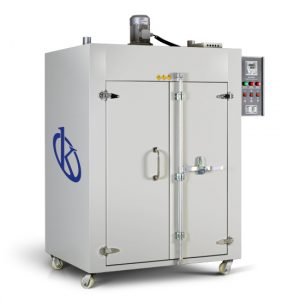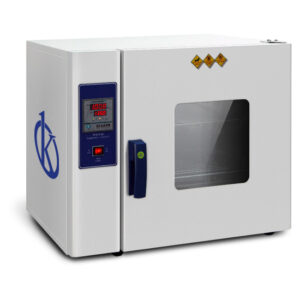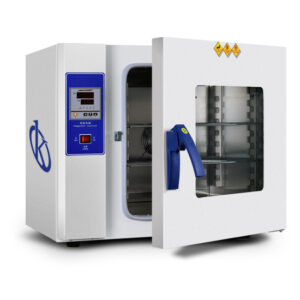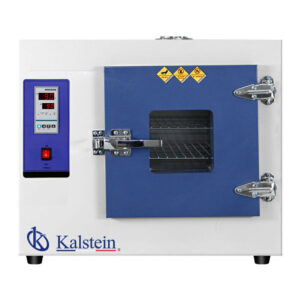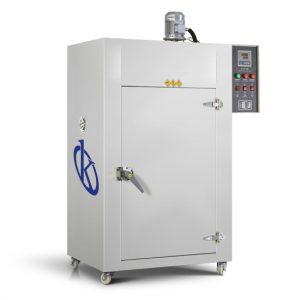Ovens
Ovens, also known as drying Ovens, are devices used to dry and sterilize glass and metal containers used in various laboratory processes. The laboratory Ovens allow to carry out the sterilization by dry heat, where hot air is used to carry out this process, these equipments allow a uniform distribution of heat inside, where the material is exposed to temperatures of approximately 170ºC for 2 hours.
Dry heat sterilization works by destroying microorganisms by oxidation of their cellular components. This is a less efficient process than wet heat sterilization because microorganisms die more quickly when in the presence of water because it allows their protein configuration to be altered more easily and provides a means to distribute heat evenly throughout the sterilizing equipment's internal chamber. For this reason, to achieve the sterilization of the material using dry heat, higher temperatures should be applied for a longer time.

Types of Ovens a Laboratory May Need
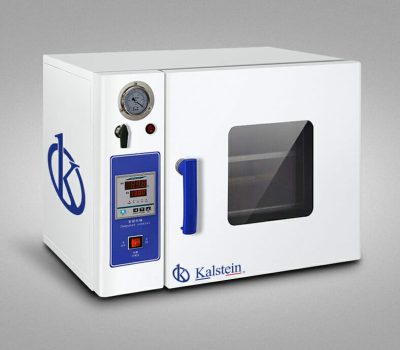
Vacuum Oven
Vacuum drying furnace widely used in biochemistry, chemistry, pharmaceutical, health care, agricultural research, environmental protection and other research applications for drying and roasting powder as well as disinfection and sterilization of glass containers used. Particularly suitable for the drying of heat sensitive, easily decomposable and complex composition articles of easily oxidized materials for quick and efficient drying.
Widely used in biochemistry, chemistry, pharmaceutical, medical care, agricultural research, environmental protection and other research applications for drying and roasting powder as well as disinfection and sterilization of glass containers used. Particularly suitable for the drying of heat sensitive, easily decomposable and complex composition articles of easily oxidized materials for quick and efficient drying.
Oven With Drying
To sterilize using hot air it is necessary to place the objects in a Ovens. And bring the indoor air to a temperature between 150 and 190 degrees C. The sterilization time must be determined for each type of material, for example, in the case of materials that are quite resistant to heat, higher temperatures can be used for shorter periods of time.
One of the first equipment used for this purpose was the Pasteur ovens, which was later replaced by hot air Oven. The drying Ovens are composed of a double chamber, and the hot air produced by an electrical resistance circulates through the main cavity and the space between both chambers, at variable temperatures, being the most recommended 170º C for the metal instruments and 140º C for the content of the drums. A stable temperature is maintained through metal thermostats called bimetallic pair, which consist of two metals of different coefficient of expansion. When one dilates, the other does not and arches. One end of this device is in contact with a switch that cuts off the power to the heating resistor.
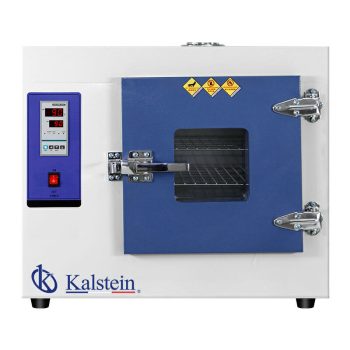
In Kalstein you can find the ideal Ovens for your Laboratory
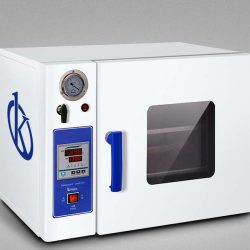
Vacuum Drying Oven YR05260 (A) // YR05261 (A)
Compare with ordinary drying form depends on air circulation for drying, dust sample is not easy to fly by flowing air...
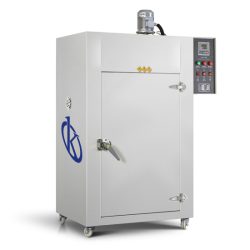
Industrial One Door Air Drying Oven
The housing is made of high quality cold rolled steel with metal spray paint with a nice overall color design. Suitable for all ...
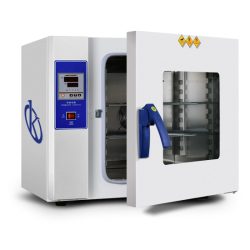
Electric Heating Drying Ovens YR05248
The shell is made of high quality cold rolled steel with environmental electrostatic spray treatment with a color design...
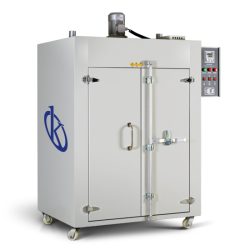
Double Door Industrial Air Drying Oven YR05257-1
Double layer door; Microcomputer intelligent temperature control, digital display; centrifugal wind wheel, heat flow evenly...
Our Best Selling Oven
To sterilize by means of hot air it is necessary to place the objects in a Oven. And bring the indoor air to a temperature between 150 and 190 degrees C. One of the first appliances used for this purpose was the Pasteur furnace, which was later replaced by hot air Ovens. These consist of a double chamber, the hot air generated by an electrical resistance circulates through the main cavity and the space between both chambers, at variable temperatures, being the most recommended 170º C for metal instruments and 140º C for the content of drums.
A stable temperature is maintained by metal thermostats called bimetallic pair, consisting of two metals of different coefficient of expansion. When one dilates, the other does not and arches. One end of this device is in contact with a switch that cuts off the power to the heating resistor.
| Model | YR05257-1 | YR05259-1 |
| Supply voltage | 380 | |
| Temp. Rang(℃) | RT+5~250 | |
| Timer Range | 0~999h | |
| Temp. Accuracy | ±1 | |
| Temp. Fluctuation(%) | ±2 | |
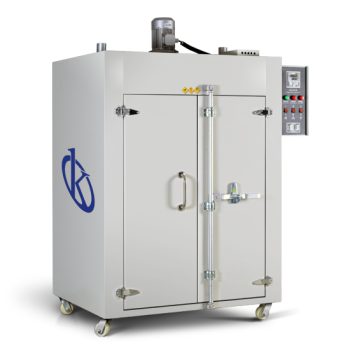
Analysis of the best Ovens for your Laboratory
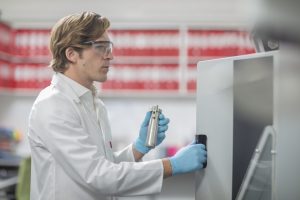
Drying ovens or ovens: Are they sterilizers?
The ovens or also called drying oven is a device used to dry and sterilize glass and metal containers...
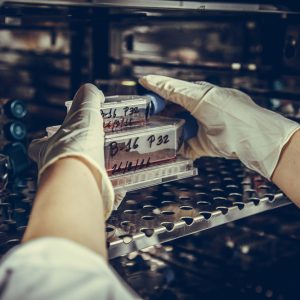
Laboratory Ovens: dry heat sterilization
Dry heat sterilization works by destroying microorganisms by oxidation of their cellular components...

Features and care of a laboratory ovens
The Ovens are composed of two chambers: an internal and an external one. The external camera is made of...

Importance of a drying oven in a laboratory
The Ovens consist basically of two chambers: an internal and an external. The external camera...
Catalog of models of Ovens on offer
-

Double Door Industrial Air Drying Oven YR05257-1 // YR05259-1
Select options This product has multiple variants. The options may be chosen on the product page -

Single Door Industrial Air Drying Oven YR05256 // YR05258
Select options This product has multiple variants. The options may be chosen on the product page -

Vacuum drying oven YR05260 (A) // YR05261 (A) // YR05264 (A)
Select options This product has multiple variants. The options may be chosen on the product page -

Vacuum Drying Oven YR05265-1 (SS) // YR05995 (S)
Select options This product has multiple variants. The options may be chosen on the product page
Guides to become an expert in Ovens
How does a natural convection Oven work?
A laboratory Ovens by natural convection is one that extracts air from the environment in which the Oven is located...
What kinds of Laboratory Ovens are there?
The laboratory Ovens or drying oven is equipment used to dry and sterilize glass and metal containers in a laboratory. It is also...
The drying Oven: from the simple to the complex
It is also identified by the name Drying oven. The manufacturers have basically developed two types...
Considerations to take into account when using a drying Oven?
The drying Ovens is used to sterilize or dry the glass and metal material used in the examinations or tests, which is carried out by the laboratory and comes from the washing section, where it is sent after being used in some...
Videos of Ovens in operation
In this section you can find videos of our Ovens in operation, packaged, receiving service, etc.
Operating Ovens
The Ovens are made up of two chambers: an internal and an external. The outer chamber is made of steel sheet, coated with a protective film of electrostatic paint. The internal chamber is usually made of aluminum or stainless material to transmit heat better; it has a set of shelves or shelves made of stainless steel wire, so that the air circulates freely, there the elements that require to be dried or sterilized by dry heat are deposited. It is insulated from the external chamber by an insulating material that internally maintains the high temperature conditions and delays the transfer of heat to the outside.
 blanco" ]
blanco" ]
Frequently asked questions about Ovens from our customers
How to know the prices of Ovens?
To know the price of Ovens we invite you to send us an email with your request through the contact form.
What are the delivery times of the Ovens?
The delivery time of your Kalstein product will depend on the following:
- If the equipment of your interest is in stock or if it must be manufactured.
- The type of freight you have chosen may be either air or sea.
- Equipment in stock:
– Delivery Time (Air): 15-30 days.
– Delivery Time (Maritime): 45-60 days.
- Equipment not in stock:
– Delivery Time (Air): 30-60 days.
– Delivery Time (Maritime): 60-90 days.
How to make a purchase of Ovens ?
You can purchase through:
- By email: s[email protected]
- By telephone: +33 (0) 1 78 95 87 02
- E-commerce: Via Kalstein's official website in your country.
How does the warranty work?
At Kalstein, we provide our customers with induction and technical support through new online methods. You can visit our induction videos, technical assistance and guidance provided by a Kalstein team through our YouTube channel (Kalstein English). HERE
Can I request a quote online?
Of course, you can request a quote for the Kalstein team of your interest, directly from our official website. Once you have identified your preferred model, click HERE
Send us a direct message and one of our agents will contact you
Error: Contact form not found.

